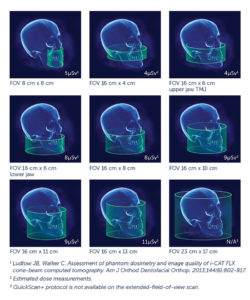By Sean Carlson, DMD, MS

Cone Beam 3D scanning is being integrated into the imaging protocol of orthodontists who want an improved and more accurate view of the teeth, roots, TMJ, airway, sinuses, bone, and all of their detailed spatial relationships. With it, we can calculate the optimal directions of orthodontic forces, determine anchorage requirements, obtain detailed measurements of airway, and access other details that affect our patient’s dental and physical health. All of this data facilitates more precise orthodontic treatment. However, some wonder if the X-ray exposure will compromise their ability to adhere to radiation protocols following the ALARA (as low as reasonably achievable) principle. The answer is a resounding “no.” In fact, Cone Beam 3D scanning can be done with less exposure.
A new study by Dr. John Ludlow, one of the foremost experts on X-ray dosimetry and effective dose related to dental imaging, shows that 3D information can be obtained with lower radiation dose than traditional 2D imaging methods. Dr. Ludlow’s analysis notes that i-CAT® FLX QuickScan+ scans expose patients to less effective dose than the combined doses of representative modern 2D digital panoramic and cephalometric radiographs.
When QuickScan+ protocols can be used, they will provide a clinically meaningful reduction in dose.
The Ludlow study notes, “We have shown that the QuickScan+ protocol provided a substantial 87% reduction in dose compared with the standard exposure protocols in both child and adult phantoms. Thus, when QuickScan+ protocols can be used, they will provide a clinically meaningful reduction in dose.”
The study is also significant to orthodontists because measurements were surveyed for both adults and children. The study continues, “The largest Quick Scan+ dose recorded in this study (18 µSv) was for the 13 x 16-cm child cephalometric scan. This dose is little more than two days of per capita background radiation in the United States. The full FOV QuickScan+ protocols are also less than the combined doses of representative modern digital 2-dimensional panoramic and cephalometric radiographs (14-24 and 4 µSv, respectively).”
With the i-CAT FLX, orthodontists reap the benefits of 3D imaging at less than half the radiation dose.
To hear more about lower radiation dose in 3D Cone Beam imaging, listen to Dr. Carlson’s podcast.
About the Author:
Dr. Sean Carlson is a board certified orthodontist who received his dental degree from Harvard University in 1994, where he was awarded the American Association of Orthodontists Award. He received his orthodontic specialty training and his master of science degree in oral biology from the University of California at San Francisco. He is currently an associate professor of orthodontics at the University of the Pacific School of Dentistry and maintains a private practice in Mill Valley, California. Dr. Carlson is a senior investigator in the Craniofacial Research and Instrumentation Laboratory at the University of the Pacific. He has served as principal investigator for a series of research grants and has published numerous papers and abstracts on a variety of clinical and theoretical subjects.
